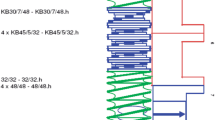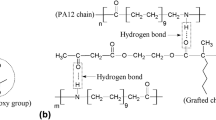Abstract
Two-component injection moulding is a manufacturing process used to combine polymers with different properties within a single product. The process is often used to combine thermoplastics of different colours or to combine thermoplastic elastomers with thermoplastics to create hard and soft areas. In this study, a two-component injection moulding process is proposed for combining thermoplastics with thermoset rubbers. This poses technological challenges since rubbers require a heated mould (160–200 ∘C) for the rubber to vulcanise whereas thermoplastics need a relatively cold mould (20–100 ∘C) for the polymer to solidify. The mould used for this study is equipped with thermally separated mould cavities and allows to reverse the injection sequence of the two materials. It was found that the optimal sequence is to inject the thermoplastic first, followed by rubber, and that the mould temperature at the interface during the vulcanisation of the rubber is a critical process parameter. Too low mould temperatures at the interface result in long vulcanisation times and poor adhesion, whereas higher temperatures at the interface both decrease the vulcanisation time and increase the adhesion strength. However, when the temperature is too high, the adhesion strength decreases again due to gas bubbles at the interface released during the vulcanisation process.
Similar content being viewed by others
References
Osswald T A, Turng L S, Gramann P (2008) Injection molding handbook. Hanser, Munich, p 65, 431–435
Schneegans D, Gattringer R (2005) Mehrkomponenten-Spritzguss. Kautsch Gummi Kunstst 58:16–21
Kamal M R, Isayev A, Liu S -J (2009) Injection molding technology and fundamentals. Munich, pp 55–60
Ciesielski A (1999) An introduction to rubber technology. Rapra Technology Limited, Shawbury, pp 63–75, 140
Linday JA. (2012) Practical guide to rubber injection moulding. Smithers Rapra, London, p 14, 47–54, 69
Schneegans D, Gattringer R, Bauer R (2007) Neue Kunststoff-Kautschuk-Verbunde mit grossem Innovationspotenzial. Gummi Fasern Kunststoffe 60:494–499
Islam A, Hansen H N, Bondo M (2010) Experimental investigation of the factors influencing the polymer–polymer bond strength during two-component injection moulding. Int J Adv Manuf Technol 50:101–111
Meister S, Drummer D (2016) Micro assembly injection moulding with variothermal mould tempering. Microsystem Technology
Guilong W, Guoqun Z, Huiping L, Yanjin G (2010) Analysis of thermal cycling efficiency and optimal design of heating/cooling systems for rapid heat cycle injection molding process. Mater Des 31:3426–3441
Guilong W, Guoqun Z, Huiping L, Yanjin G (2011) Research on optimization design of the heating/cooling channels for rapid heat cycle molding based on response surface methodology and constrained particle swarm optimization. Expert Syst Appl 38:6705–6719
Zaimova D, Bayraktar E, Dishovsky N (2011) State of cure evaluation by different experimental methods in thick rubber parts. J Achiev Mater Manuf Eng 44:161–167
Brown R (2011) Physical testing of rubber. Springer, New York, pp 63–94
Pazur RJ, Walker FJ (2009) State of cure measurements in peroxide and sulfur cured EPDM. Rubber World 204:25–35
Arrillaga A, Zaldua AM, Farid AS (2010) Evaluation of injection-molding simulation tools to model the cure kinetics of rubbers. J Appl Polym Sci 123:1437–1454
Khimi SR, Pickering KL (2014) A new method to predict optimum cure time of rubber compound using dynamic mechanical analysis. J Appl Polym Sci 131:1–6
Jabbari E, Peppas NA (1994) Polymer-polymer interdiffusion and adhesion. J Macromol Sci 34:205–241
Thust T (2014) Rezeptur- und Prozesseinflüsse auf das Haftverhalten beim Mehrkomponentenspritzgiessen von Thermoplast-Elastomer-Verbundbauteilen am Beispiel PA6.6 - HNBR. Dissertation. Deutschen Institut für Kautschuktechnologie
Brauer M, Hupfer B, Nagel J, Lehmann D (2002) Chemical modification of polyurethane for two-component injection molding. Polym Eng Sci 42:859–869
Pompe G, Brauer M, Schweikle, Nagel J, Hupfer B, Lehmann D (2006) Influence of the temperature profile in the interface on the bond strength of polyamide–polyurethane two-component tensile bars. J Appl Polym Sci 100:4297–4305
Acknowledgements
G. Bex acknowledges Research Foundation—Flanders (FWO) for funding his PhD grant Strategic Basic Research. The authors also acknowledge the company Hercorub NV for providing the uncured rubber material.
Author information
Authors and Affiliations
Corresponding author
Rights and permissions
About this article
Cite this article
Bex, GJ., Desplentere, F., De Keyzer, J. et al. Two-component injection moulding of thermoset rubber in combination with thermoplastics by thermally separated mould cavities and rapid heat cycling. Int J Adv Manuf Technol 92, 2599–2607 (2017). https://doi.org/10.1007/s00170-017-0341-y
Received:
Accepted:
Published:
Issue Date:
DOI: https://doi.org/10.1007/s00170-017-0341-y




